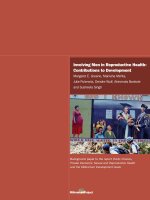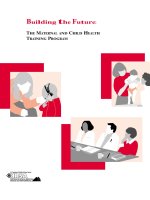Tài liệu NIEHS/EPA Children’s Environmental Health and Disease Prevention Research Centers: Protecting Children’s Health for a Lifetime pptx
Bạn đang xem bản rút gọn của tài liệu. Xem và tải ngay bản đầy đủ của tài liệu tại đây (1.08 MB, 4 trang )
NIEHS/EPA Children’s Environmental Health
and Disease Prevention Research Centers:
Protecting Children’s Health
for a Lifetime
1997: President Clinton signs
Executive Order 13045, Protection of
Children from Environmental Health
Risks and Safety Risks, which
directs federal agencies to identify
and assess environmental risks
to children’s health.
1998: Eight Children’s Centers are
est
ablished by NIEHS and EPA,
with a research emphasis on
children’s asthma and other
respiratory diseases, as well
as ways to reduce exposure
to pesticides for children in
agricultural settings.
2001: The program is expanded to include
research on neurobehavioral disorders
with the addition of four Centers – two
dedicated to research on environmental
factors potentially related to autism, one
on the impact of exposure to mercury
and PCBs, and one designed to quantify
the impact of low-level environmental
toxicants on child development.
2004: Six Centers are awarded a
sec
ond round of funding and a new
Center is added to the program.
The mission of the Children’s Centers program is to reduce
children’s health risks, protect children from environmental
threats and promote their health and well-being in the
communities where they live, learn and play.
Background
For many reasons, children are likely to be more vulnerable
than adults to the effects of environmental contaminants.
To better understand the effects of these exposures, the
NIEHS/EPA Children’s Environmental Health and Disease
Prevention Research Centers (Children’s Centers) were
established to better understand environmental factors
affecting children’s health, and to promote translation of
basic research findings into intervention and prevention
methods to promote the health of children.
Fourteen Children’s Centers are currently funded,
12 of
which were funded in 2010, including six five-year
Centers and six three-year grants for smaller Formative
Centers. The program is designed to foster research
collaborations among basic, clinical, and behavioral
scientists, with participation from local communities.
The Children’s Centers program is also part of the NIEHS
Partnerships in Environmental Public Health, an umbrella
program that brings together scientists, community
members, educators, health care providers, public health
officials, and policy makers in the shared goal of advancing
the impact of environmental public health research.
5-Year Grants
These larger grants are awarded to research institutions
to assemble teams of multidisciplinary scientists from
a range of fields to study complex problems during a
five-year period. These Centers are researching questions
about children’s exposures to a range of pollutants and
compounds and their potential effects on development
and learning. Environmental factors in diseases such as
asthma, immune disorders, autism, and obesity are also
being studied. An additional component of these
Centers is to administer outreach programs in
close collaboration with the local community.
3-Year Grants
Funded for a three-year period, the Formative Centers are
exploring new and emerging areas of science in children’s
environmental health, while pioneering innovative
techniques and approaches. Areas of research include
health effects of exposure to air pollutants, endotoxin,
BPA, phthalates, lead and arsenic as related to birth defects,
asthma, endocrine-mediated changes, brain development
and behavior.
NIEHS/EPA Children’s Centers Program Goals
n
Promote and accelerate translation of basic research findings into applied intervention and prevention methods and strategies.
n
Enhance communication, innovation and research.
n
Promote multidisciplinary interactions among basic scientists, clinicians and behavioral and social scientists.
n
Generate data from multiple scientific disciplines to understand the persistent effects of chemicals and other exposures on the fetus
and child as they relate to brain and organ system development, growth and development of the child through young adulthood.
2006: Another Center receives an
additional award and a new
Center is funded.
2007: Based on program evaluations, a workshop,
and public input, NIEHS and EPA modify the
program to include new research areas
with both 5-year Centers and 3-year
Formative Centers, to increase flexibility
and create a more dynamic network.
2010: The revised Children’s
Ce
nter program funds six
5-year Centers and six 3-year
Formative Centers.
Research at the Formative
Centers includes emerging
areas of science in children’s
health, incorporating
innovative approaches.
As of 2011, a total of 14 Children’s
Ce
nters are supported.
Children’s Centers Program Successes: Examples
Since the inception of the Children’s Centers program,
researchers have laid the scientific foundation for a
new way of thinking about children’s health and the
environment. The list below includes just a few of the
many important Children’s Centers’ research findings
that are improving the lives and health of children today.
• Children’s Centers’ research has found that people
differ in their ability to metabolize pesticides.
This finding is of particular concern
during pregnancy and early
childhood, as children do not
appear to fully develop the
ability to metabolize some
pesticides even up to age 7,
putting them at greater risk
of adverse health effects.
• Research conducted in southern California has focused
on the health of children living close to major roadways.
Studies have shown that childhood exposure to freeway
traffic increases the risk for asthma. Also, mothers living
near major roadways during pregnancy may be at higher
risk of having a child with autism.
• Prenatal exposure to polycyclic aromatic hydrocarbons
(PAHs), a component of combustion, such as vehicle
exhaust, can lower a child’s IQ, and in one study were
found to be related to cognitive delay at age 3.
• Children with autism are more likely than normally
developing children to have impairments in mitochondrial
activity, which may increase susceptibility to environmental
exposures.This finding of dysfunction in mitochondrial
energy production could lead to new diagnostic tools
for autism and other neurodevelopmental disorders.
• Mothers who reported taking prenatal vitamins
three months prior to conception, and who continued
taking them at least through the first month of pregnancy,
were less likely to have a child with autism
.
• Maternal exposure to polybrominated diphenyl
ether (PBDE) flame retardants is associated with lower
thyroid-stimulating hormone levels during pregnancy,
which may have implications for maternal health and
fetal development.
• Exposures to environmental chemicals, such as
polychlorinated biphenyls (PCBs) and
lead, are
associated with deficits in many neurobehavioral
functions that are also impaired in children with
attention
deficit hyperactivity disorder (ADHD).
• Children’s Centers’ research has shown that even very
low levels of lead exposure can result in intellectual
impairment in children. These studies suggest that there
is no discernable threshold for the adverse effects of lead
exposure and that many more children than previously
estimated are affected.
•
A series of Lessons Learned papers from the collective
experience of the Children’s Centers in areas including
asthma, air pollution, neurodevelopment, research
methodologies and community-based participatory
research were published in Environmental Health
Perspectives in 2005 in support of the National
Children’s Study.
• The Mount Sinai School of Medicine Children’s
Environmental Health Center, a previously co-funded
NIEHS/EPA Center, is one of three institutions in the
United States to be selected to participate in the puberty
study sponsored by the transdisciplinary Breast Cancer
and the Environment Research Program, which is
co-funded by NIEHS and the National Cancer
Institute. The Center will work with its existing cohort
of 7- and 8-year-old girls in East Harlem to shed light
on environmental and genetic determinants of puberty.
•
Two Children’s Centers are part of the Disease Investigation
Through Specialized Clinically Oriented Ventures in
Environmental Research (DISCOVER) Program, which
has the long range goal of developing new clinical and
public health applications to improve disease prevention,
diagnosis and therapy.
Emerging Areas of Research
Today, the NIEHS/EPA Children’s Centers are poised to make more contributions to the scientific
understanding of complex interactions between the environment, genetics, and other factors
and how those interactions affect children’s health from preconception to young adulthood.
Recently, several new and often interconnected areas of scientific inquiry have emerged,
including:
• Obesity: What is the role of environmental factors in the epidemic of obesity among our
nation’s children?
• Endocrine Disrupting Chemicals: How are widespread exposures to chemicals
that interfere with the body’s endocrine system affecting children, particularly
during vulnerable windows of development?
• Epigenetics: How do modifications to DNA resulting from diet, aging, stress,
and/or environmental exposures affect our children or our grandchildren?
• Microbiome: How do helpful microorganisms in the gastrointestinal tract
affect children’s health? How is the microbiome affected by environmental
exposures, including diet, antibiotic use and chemicals?
NIEHS and EPA are committed to protecting the health of children wherever they are –
the urban playground, the suburban school, or the rural community and are committed to
eliminating environmental health disparities and improving the health of all children.
The ultimate goal of the Children’s Environmental Health and Disease Prevention Research
Centers is to create a healthy and sustainable environment, for every child, at every stage, in
every community across the nation.
NIEHS/EPA Children’s Environmental Health and Disease Prevention Research Centers
Contacts
Kimberly Gray, Ph.D.
Scientific Program Administrator
NIEHS, NIH
Richard Callan, M.P.H.
Environmental Health Scientist
NCER, EPA
Nica Louie, M.S.
Environmental Health Scientist
NCER, EPA
NIEHS: 111 TW Alexander Drive, PO Box 12233,
Research Triangle Park, NC 27709
919-541-3345
www.niehs.nih.gov
USEPA: 1200 Pennsylvania Avenue NW
Mail Code 8723P, Washington, D.C. 20460
703-347-8051 or 703-347-8125
www.epa.gov/ncer
Printed on 30% post-consumer
content using soy-based inks
January 2012









